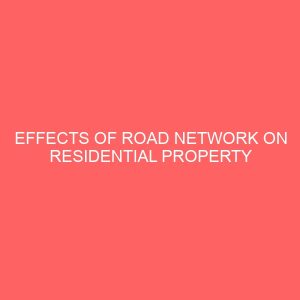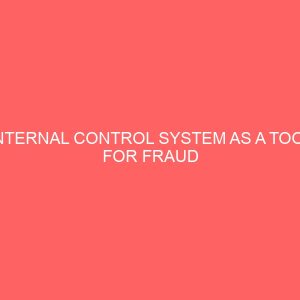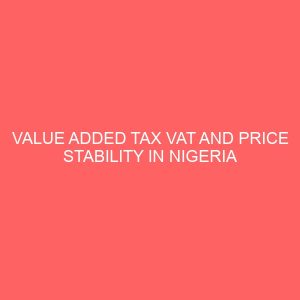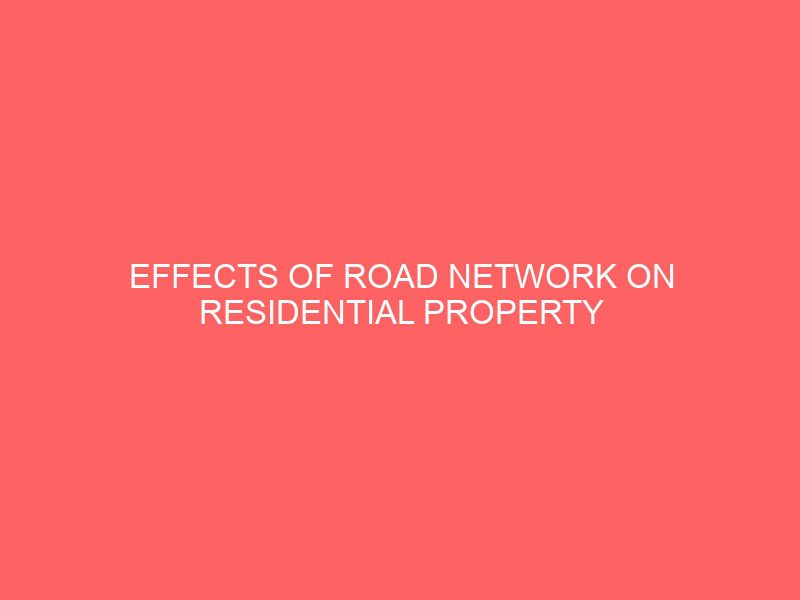Description
CHAPTER ONE
INTRODUCTION
- BACKGROUND TO THE STUDY
This project is on Effects of road network on residential property development (case study: Bori town, Rivers state). The road network is the system of interconnected roads designed to accommodate wheeled road going vehicles and pedestrian traffic. The road network consists of a system of interconnected paved carriageways which are designed to carry buses, cars and goods vehicles; the road network generally forms the most basic level of transport infrastructure within urban areas, and will link with all other areas, both within and beyond the boundaries of the urban area.
Transportation and property are important in physical and economic development of towns and cities all over the world. Property and land values tend to increase in areas with expanding transportation networks, and increase less rapidly in areas without such improvements. Rapid and continued rise in housing and land prices are expected in cities with transportation improvements and rapid economic and population growth (Goldberg, 1970).
Various organizations engage in road network management. They include the town, city and regional authorities for road networks at every level. There are control centres dedicated to managing the traffic control systems for urban networks, motorways and other strategic roads, as well as for toll roads, tunnels and bridges. Each organization will have a different perspective on the significance of ITS applications and services but most stand to gain some improvement in network efficiency, for example: by optimizing road users’ use of the network through improved journey planning with real-time information and satellite through traffic management and other measures like speed and access control, or public transport priority measures – that help deliver transport policy goals, such as eco-driving and the safe and efficient use of road space ( See Traffic Management ) by monitoring the status and condition of the network in real-time for rapid detection of incidents, emergencies and weather events with electronic payment technologies that enable toll charges and demand management measures to be implemented flexibly through multi-modal information and payment systems that will promote inter-modal transfers and road transport that is better integrated with other modes
In these ways, the community’s requirements for mobility and commerce can be met more effectively and the need to construct new or expanded roadway facilities can be reduced: ITS can maintain or expand the level of service to road users whilst increasing traffic throughput (measured in terms of the number of people, or number of vehicles, or amount of goods moved per unit time. ITS can also support management of infrastructure at times of extreme events (such as flooding, extreme storms), by providing high- performance real-time information to operators and users (See Integrated Strategies).
Road networks are observed in terms of its components of accessibility, connectivity, traffic density, level of service, compactness, and density of particular roads. Level of service is a measure by which the quality of service on transportation devices or infrastructure is determined, and it is a holistic approach considering several factors regarded as measures of traffic density and congestion rather than overall speed of the journey (Mannering, Walter, and Scott, 2004).
Access to major roads provides relative advantages consequent upon which residential users locate to enjoy the advantages. Modern businesses, industries, trades and general activities depend on transport and transport infrastructure, with movement of goods and services from place to place becoming vital and inseparable aspects of global and urban economic survival. Developments of various transportation modes have become pivotal to physical and economic developments. Such modes include human porter age, railways, ropeways and cableways, pipelines, inland waterways, sea, air, and roads (Said and Shah, 2008).
According to Oyesiku (2002), urbanization in Nigeria has a long history in its growth and development. Extensive development being a feature of the 19th and 20th centuries, with concentration of economic and administrative decision-making in Lagos, Ibadan, Kaduna, Jos, and Enugu, and high degree of specialization and larger population associated with greater specialization of goods and services. Wyatt (1997) states that urban areas have tendency to develop at nodal points in transport network and places with good road network will possess relative advantage over locations having poor network. Urban locations with such relative advantage are found where different transport routes converge with high degree of compactness, connectivity, density, length and accessibility exhibited within the intra- and inter- urban road networks.
Bori community in Rivers is a typical area dominated by farmers who needs good transportation network towards transporting the farm produce to the point of consumption. The present position concerning residential properties in Bori is that majority are located along arterial roads that deliver much of the vehicular and pedestrian movements. There have been increases in rental values along the individual arterial roads although not at equal rates. It is against this background that this research analyzed the arterial roads, determined the levels of accessibility, connectivity, traffic density of the individual arterial roads, examined the pattern of residential property values and the relationship between the explanatory variables of the road network in Bori, Rivers state.
1.2 STATEMENT OF THE RESEARCH PROBLEM
The relationship between transportation and urban property values has been the focus of many studies (for example, Dewees, 1976; Damm et al, 1980; Wolf, 1992; Singh, 2005). Some of the earlier studies returned positive relationship between transport and property values while others showed negative relationship. For instance, in a study on the relationship between rail travel cost and residential property values, a replacement of streetcar with subway increased site rent at a location that is perpendicular to the facility within a one-third mile walk to the station (Dewees, 1976); and there was positive influence of permanent transportation improvements on land values (Wolf, 1992). It was established that there was statistically significant relationship between distance of a parcel of land to the nearest Metro station and land price (Damm, Lerner-Lam, and Young, 1980), while there was evidence that residential property prices decrease immediately around the transport investment or station value uplift through changes in land values (Singh, 2005).
The urban areas all over the world offer a number of advantages in terms of concentration of people followed by demand for residential properties and transportation. Bori is a classical example of a city that has developed rapidly, construction of roads increased substantially with the opening up of residential precincts that also benefitted from increasing demand for lettable spaces in residential properties. Many private companies, retail stores, residential banks aggregate in the metropolis to take advantage of opportunities afforded by locations near the seat of governance thus attracting complimentary services. This led to high concentration of vehicular and pedestrian movements especially along the access roads.
The roads exhibit a number of nodes and linkages to form networks of both arterial and minor routes along which residential properties locate. Residential users displaced residential users, causing sites to be at highest and best uses with concomitant increases in the values of residential properties. Accessibility within the road network is affected by the compact nature of various routes that sometimes impede volume of traffic. The road network is made up of nodal points and links that determine the degree of connectivity and accessibility in the network.
A number of factors affect values of properties. These factors may be intrinsic or extrinsic. The extrinsic factors include increase in demand for lettable space, location, condition of adjoining properties, nearness to park and leisure, local and national economic conditions. External factors are due to natural characteristics of the property which affect the city where the property is located. Intrinsic factors arise from within the nature of the property itself and relate to the physical attributes, including size of room, state of repair, decoration, and facilities. Other attributes that increase or decrease the amount that users are willing and able to pay in an open market transaction include physical characteristics of the structure, change in taste and demand, effect of adjacent activities, economic activities, inflation, and changes in legislation. The demand for residential properties itself is affected by changes in population, planning and development schemes, legislation, and availability of good road networks (Hendon, 1971; William, Davies, and Johnson, 1980; Richmond, 1982; Millington, 1982; Olayiwola, Adeleye and Oduwaye, 2006).
Earlier theorists (Burgess, 1925; Hoyt, 1939; Harris and Ullman, 1951; Lean and Goodall, 1977) generally believe that sites adjacent to main transport routes have relative advantages over those located some distance away, and other sites located at route intersections possess relative advantage with greater advantages belonging to sites located at focus of transport system. These advantages are determined in relation to accessibility, which has different characteristics in relation to individual sites thus differentiating between sites in terms of accessibility advantages.
Many of the aforementioned studies emphasized the effects of the factors on values of properties generally with little consideration given to road network pattern and its effects on values of residential properties. Possible relationships between road networks, location attribute, demand and supply, and accessibility and residential property values have therefore elicited the interest of the researcher in this direction. The relationship cannot be determined without due consideration given to the explanatory variables on one hand and residential property values on the other. The use of roads leads to a study of urban areas in relation to land uses, especially residential properties. It is against this background that this study was conceived.
1.3 RESEARCH QUESTIONS
The foregoing has elicited a number of questions in terms of road network analysis and values of residential properties in Bori, Nigeria to which answers are to be proffered. The relationship between arterial road network and residential property values cannot be determined without due consideration given to variables that make up the network, especially those that relate to arterial roads and other explanatory variables and values of residential properties. Some pertinent questions to enable the study attain its stated objectives are as follows:
- What is the relationship between road network and residential property development?
- How effective and efficient is the road network in Bori in fostering residential property development?
- What are the problems encountered through road network system in Bori?
- Does the road system have any negative influence on the residential properties in Bori?
- What are the spatial pattern and trend of residential property values in the study area?
- What are the relationships between residential property values and arterial road network in the presence or absence of other explanatory variables?
1.4 AIM AND OBJECTIVES OF THE RESEARCH
The aim of this research is to analyze the network of arterial roads and other explanatory variables and residential property values in Bori, while the specific objectives are to:
- To examine the significant relationship between road network and residential property development
- To examine the effectiveness and efficiency of the road network in Bori in fostering residential property development
- To discover the challenges encountered through road network system in Bori
- To ascertain if the road system have any negative influence on the residential properties in Bori?
- Determine the relationships between residential property values and road network, in the presence or absence of other variables, in the study area;
- Determine the contributions of individual explanatory variables to variability in residential property values in the study area;
1.5 RESEARCH HYPOTHESES
Consequently, the following hypotheses were postulated:
- There is no significant relationship between residential property values and independent explanatory variables in the study area.
- There are no differences in individual contributions of explanatory variables to variability in residential property values in the study area.
1.6 SIGNIFICANCE OF THE STUDY
It is trite amongst earlier studies on accessibility in relation to property values that profitability and utility are determined by accessibility. The greater the accessibility of a location the greater the comparative advantage, and the greater the comparative advantages the greater the demand for property at the location. Lean and Goodall (1977), for instance, stated that urban areas naturally develop at nodal points in the transport network and those locations with good transport access to other areas have relative advantage over locations with poorer transport facilities and that urban locations having such relative advantages are likely to be where transport routes converge.
Similarly, Estate Surveyors/Valuers and Planners believe that accessibility has great impacts on property values, with properties along major roads and at nodal points having greater values (Ogunsanya, 1986; Oduwaye, 2004; Omoogun, 2006). However, accessibility discussed in these studies was based on intuition without empirical basis to justify what relative accessibility advantages the locations have. This study borrows techniques found useful in other fields like operational research, geography, transportation and urban planning to explain and analyze road network for purpose of determining the relative accessibility of each of the arterial roads. It is believed that the techniques used in these fields can be extended to studies in estate management, thereby making cross-fertilization of research ideas across various fields possible. In this regard, this research has become relevant in determining the relationship between arterial road network and values of residential properties in Bori.
In addition, it is essential to establish a technique that may be useful for determining relative accessibility of locations in the network of arterial roads. Even when relative advantages are determined, there is need to develop models that will be useful for predicting residential property values in Nigeria. The model may become tool for professional Estate Surveyors and Valuers to change their practice of using intuition to determine relative accessibility of locations in a road network. Similarly, there is the need to predict the supply of, demand for, and fair market values of residential properties by developers, Estate Surveyors and Valuers, and feasibility and viability appraisers in present day’s risks and uncertainty in property development. This has underscored the importance of this study.
1.7 SCOPE OF THE STUDY
Roads may be classified as international, inter-city or intra-city. International and inter-city roads are usually major or arterial roads, while intra-city roads are routes within a city and may be minor or major (arterial). The study focused on arterial roads in the intra-urban network of Bori. There are ninety roads in Bori out which thirty seven are arterial. From the thirty-seven arterial roads in the study area, only twenty traverse the residential axes while others serve institutional, industrial, and residential neighborhoods. This study therefore covered all major roads serving the residential axis and inner areas of Bori to the exclusion of inter-city roads. Preliminary study revealed that there are five types of residential properties in the study area. These are retail shop premises, banking spaces, office properties, warehouses, and non-specific residential properties. In respect of this research, focus was on offices, shops, banking spaces and other types of residential users along the arterial routes to the exclusion of residential, industrial, and non-specific type of residential properties.
1.8 LIMITATIONS OF THE STUDY
The study focused on analysis of arterial roads and residential property values in Bori. It did not attempt to investigate the structural stability of the arterial road network or assess the methods and accuracy of methods adopted by respondents in fixing the values of residential properties in the study area. It simply analyzed accessibility, connectivity, arterial road network, and distance to most central place in the study area, demand and supply of residential properties in relation to residential property values in the study area. Graph theoretic technique was used to analyze the arterial road network while opinions of Estate Surveyors and Valuers practicing in the study area were relied upon. The accuracy, or otherwise, of such opinions although not in doubt was not investigated.
1.9 THE STUDY AREA
Bori is the traditional headquarters of the Ogoni people. Bori serves as a residential centre for the Ogoni, Andoni, Opobo Annang and other ethnic nationalities of the Niger Delta Benue Congo. Bori is the host of the Ken Saro Wiwa Polytechnic Bori . The Bori Urban Area has many adjoined communities including Bori Town, Bua Kaani, Yeghe, Zaakpon, Wiiyaakara, Betem 3, Kor, Kpong, and Bo-Ue. The Kaani people built and donated the first community secondary school in Nigeria to the Government of the Old Rivers State of Nigeria.
Bori is the second largest city in Rivers state after Port Harcourt and the residential center of the Rivers southeast senatorial district in Rivers state. Bori is an Agricultural hop in Rivers state involve in the production of Yams, Gari, corn, cocoyam, palm oil and vegetables. Also available are fishes and meat. The Bori main market is a daily market where these products can be bought in large quantities for local or export market.
The Bori land whose land area is 20 sq mi (50km) with a total population of 250,000 people. The density of the land is 10,000/sq mi (5,000/km) with a time zone of WAT (UTC+1)








Reviews
There are no reviews yet.